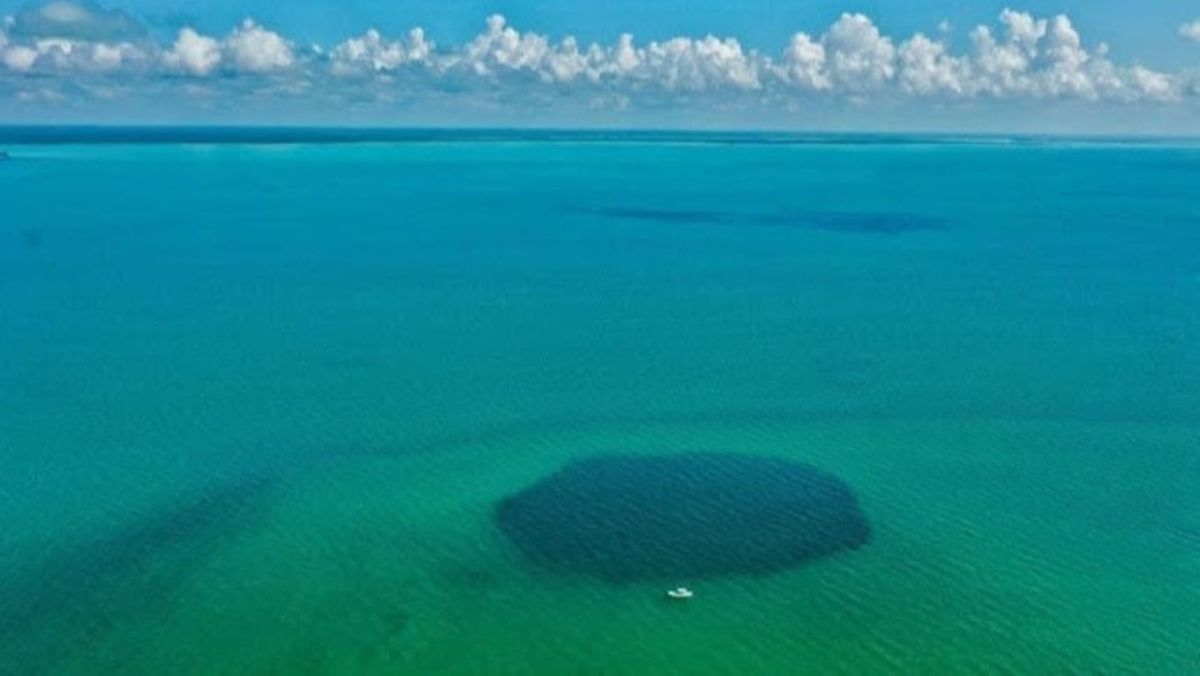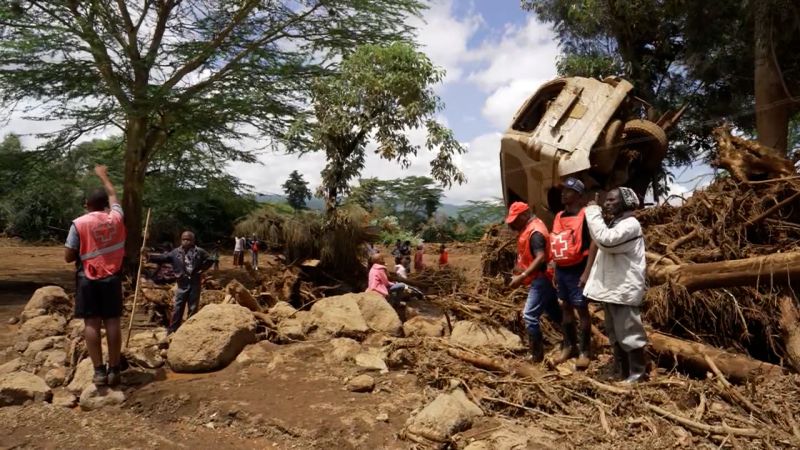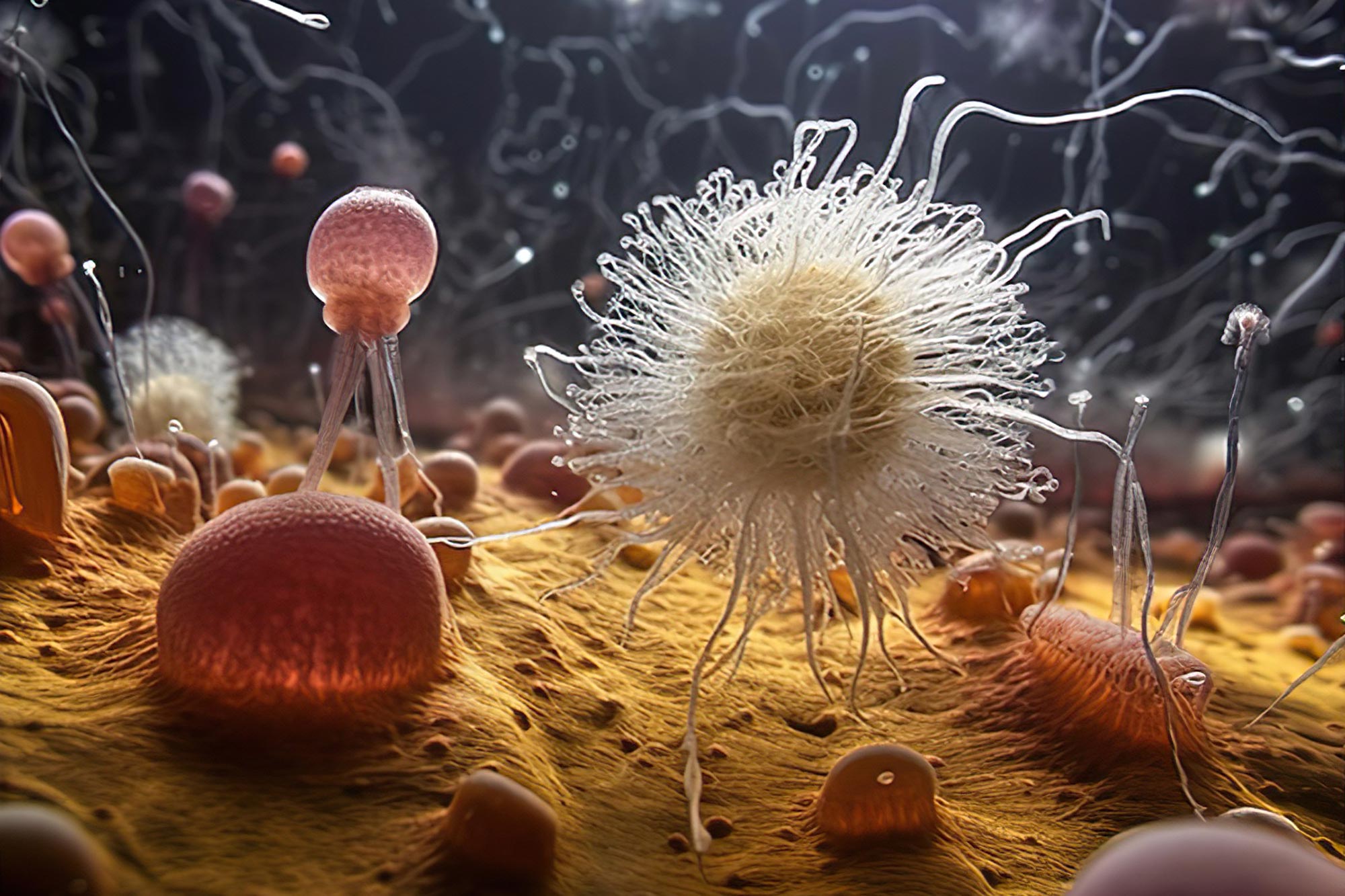بواسطة
تخيل الفنان عن مجموعة من الكائنات حقيقية النواة البدائية من “Protosterol Biota” التي تعيش على حصيرة بكتيرية في قاع المحيط. استنادًا إلى الحفريات الجزيئية ، عاشت كائنات Protosterol Biota في المحيطات منذ حوالي 1.6 إلى 1.0 مليار سنة وهي أقدم أسلافنا المعروفين. الائتمان: تم تنظيمه في MidJourney بواسطة TA 2023
وجد فريق بحث متعدد الجنسيات بروتسترويدات قديمة في الصخور ، مما يشير إلى أن الحياة المعقدة كانت موجودة منذ ما يصل إلى 1.6 مليار سنة. تقدم هذه الجزيئات نظرة ثاقبة جديدة لتطور الحياة المعقدة وتسوية التناقضات بين سجلات الأحافير التقليدية والدهنية.
تبين أن السجل المكتشف حديثًا لما يسمى بالستيرويدات الأولية كان وفيرًا بشكل مدهش في جميع أنحاء العصور الوسطى للأرض. تم إنتاج الجزيئات البدائية في مرحلة مبكرة من تعقيد حقيقيات النوى – مما أدى إلى توسيع السجل الحالي للستيرويدات الأحفورية إلى ما بعد 800 وحتى 1600 مليون سنة مضت. حقيقيات النوى هو مصطلح يطلق على مملكة الحياة بما في ذلك جميع الحيوانات والنباتات والطحالب ويتم فصلها عن البكتيريا من خلال وجود بنية خلوية معقدة تتضمن نواة ، بالإضافة إلى آلية جزيئية أكثر تعقيدًا.
يقول كريستيان هولمان ، أحد العلماء المشاركين من مركز الأبحاث الألماني لعلوم الأرض (GFZ) في بوتسدام: “إن أهم ما توصل إليه هذا الاكتشاف ليس مجرد امتداد السجل الجزيئي الحالي لحقيقيات النوى”. “بالنظر إلى أن السلف المشترك الأخير لجميع حقيقيات النوى الحديثة ، بما في ذلك نحن البشر ، كان على الأرجح قادرًا على إنتاج ستيرولات حديثة” منتظمة “، فمن المحتمل أن تكون حقيقيات النوى المسؤولة عن هذه التوقيعات النادرة تنتمي إلى جذع شجرة النشوء والتطور.”

يقوم Benjamin Nettersheim ، أحد المؤلفين الرئيسيين للدراسة ، بفحص الخرائط الأولية والجزيئية فائقة الدقة لعينات صخرية عمرها 1.64 مليار سنة تم تحليلها في مختبر التصوير الجزيئي الجيوبيولوجي في MARUM. الائتمان: MARUM – مركز علوم البيئة البحرية ، جامعة بريمن ؛ في ديكامب
يمثل هذا “الجذع” سلالة الأسلاف الشائعة التي كانت مقدمة لجميع فروع حقيقيات النوى التي لا تزال حية. ممثلوها منقرضون منذ فترة طويلة ، لكن تفاصيل طبيعتهم قد تلقي مزيدًا من الضوء على الظروف المحيطة بتطور الحياة المعقدة. على الرغم من أن هناك حاجة إلى مزيد من البحث لتقييم النسبة المئوية للبروتسترويدات التي قد يكون لها مصدر بكتيري نادر ، فإن اكتشاف هذه الجزيئات الجديدة لا يوفق فقط بين السجل الجيولوجي للحفريات التقليدية مع تلك الخاصة بجزيئات الدهون الأحفورية ، ولكنه يعطي لمحة نادرة وغير مسبوقة عن العالم المفقود من الحياة القديمة. قد يعكس الزوال التنافسي لحقيقيات النوى للمجموعة الجذعية ، الذي تميز بالظهور الأول للستيرويدات الأحفورية الحديثة منذ حوالي 800 مليون سنة ، أحد أكثر الأحداث ثباتًا في تطور الحياة المعقدة بشكل متزايد.
يضيف بنجامين نيتيرسهايم من ماروم ، جامعة بريمن ، الذي يشترك في التأليف الأول للدراسة مع يوخن بروكس من[{” attribute=””>Australian National University (ANU) – “due to potentially adverse health effects of elevated cholesterol levels in humans, cholesterol doesn’t have the best reputation from a medical perspective. However, these lipid molecules are integral parts of eukaryotic cell membranes where they aid in a variety of physiological functions. By searching for fossilized steroids in ancient rocks, we can trace the evolution of increasingly complex life.”

Dr. Nettersheim inserts a thin section and rock slices of 1.64 billion-years old rocks into the 7T solariX XR FT-ICR-MS equipped with a MALDI source at the Geobiomolecular Imaging Laboratory at MARUM. As part of ongoing research into mid-Proterozoic biomarker signatures at MARUM, GFZ and the Australian National University, Dr. Nettersheim aims to zoom into the cradle of eukaryotic life in unprecedented resolution. Credit: MARUM – Center for Marine Environmental Sciences, University of Bremen; V. Diekamp
Nobel laureate Konrad Bloch had already speculated about such a biomarker in an essay almost 30 years ago. Bloch suggested that short-lived intermediates in the modern biosynthesis of steroids may not always have been intermediates. He believed that lipid biosynthesis evolved in parallel with changing environmental conditions throughout Earth history. In contrast to Bloch, who did not believe that these ancient intermediates could ever be found, Nettersheim started searching for protosteroids in ancient rocks that were deposited at a time when those intermediates could actually have been the final product.
But how to find such molecules in ancient rocks? “We employed a combination of techniques to first convert various modern steroids to their fossilized equivalent; otherwise, we wouldn’t have even known what to look for,” says Jochen Brocks. Scientists had overlooked these molecules for decades because they do not conform to typical molecular search images. “Once we knew our target, we discovered that dozens of other rocks, taken from billion-year-old waterways across the world, were oozing with similar fossil molecules.”
The oldest samples with the biomarker are from the Barney Creek Formation in Australia and are 1.64 billion years old. The rock record of the next 800 million years only yields fossil molecules of primordial eukaryotes before molecular signatures of modern eukaryotes first appear in the Tonian period. According to Nettersheim “the Tonian Transformation emerges as one of the most profound ecological turning points in our planet´s history“. Hallmann adds that “both primordial stem groups and modern eukaryotic representatives such as red algae may have lived side by side for many hundreds of millions of years”. During this time, however, the Earth’s atmosphere became increasingly enriched with oxygen – a metabolic product of cyanobacteria and of the first eukaryotic algae – that would have been toxic to many other organisms. Later, global “Snowball Earth” glaciations occurred and the protosterol communities largely died out. The last common ancestor of all living eukaryotes may have lived 1.2 to 1.8 billion years ago. Its descendants were likely better able to survive heat and cold as well as UV radiation and displaced their primordial relatives.
“Earth was a microbial world for much of its history and left few traces,” Nettersheim concludes. Research at ANU, MARUM and GFZ continues to pursue tracing the roots of our existence – the discovery of protosterols now brings us one step closer to understanding how our earliest ancestors lived and evolved. Shooting at the ancient rocks with a laser coupled to an ultra-high resolution mass spectrometer in MARUM’s globally unique Geobiomolecular Imaging Laboratory, Dr. Nettersheim and his international collaborators aim at zooming into the cradle of eukaryotic life in unprecedented resolution to further improve our understanding of our early ancestors in the future.
Reference: “Lost world of complex life and the late rise of the eukaryotic crown” by Jochen J. Brocks, Benjamin J. Nettersheim, Pierre Adam, Philippe Schaeffer, Amber J. M. Jarrett, Nur Güneli, Tharika Liyanage, Lennart M. van Maldegem, Christian Hallmann and Janet M. Hope, 7 June 2023, Nature.
DOI: 10.1038/s41586-023-06170-w
Participating Institutions:
- Research School of Earth Sciences, The Australian National University, Canberra, Australia
- MARUM – Center for Marine Environmental Sciences, University of Bremen, Bremen, Germany
- Faculty of Geosciences, University of Bremen, Bremen, Germany
- Université de Strasbourg, CNRS, Institut de Chimie de Strasbourg, Strasbourg, France
- Northern Territory Geological Survey, Darwin, Australia
- German Research Center for Geosciences (GFZ), Potsdam, Germany
MARUM produces fundamental scientific knowledge about the role of the ocean and the ocean floor in the total Earth system. The dynamics of the ocean and the ocean floor significantly impact the entire Earth system through the interaction of geological, physical, biological and chemical processes. These influence both the climate and the global carbon cycle, and create unique biological systems. MARUM is committed to fundamental and unbiased research in the interests of society and the marine environment, and in accordance with the Sustainable Development Goals of the United Nations. It publishes its quality-assured scientific data and makes it publicly available. MARUM informs the public about new discoveries in the marine environment and provides practical knowledge through its dialogue with society. MARUM cooperates with commercial and industrial partners in accordance with its goal of protecting the marine environment.

“مدمن ثقافة البوب. عشاق التلفزيون. نينجا الكحول. إجمالي مهووس البيرة. خبير تويتر محترف.”




/cdn.vox-cdn.com/uploads/chorus_asset/file/25424932/Hover_20240429_1714372038159.0__1_.jpeg)


More Stories
اكتشاف أعمق ثقب أزرق في العالم، ويعتقد أنه يحتوي على كهوف وأنفاق مخفية بداخله
العلماء يكتشفون “مفاجأة” تغير فهمهم للكون
تطلق SpaceX 23 قمرًا صناعيًا من نوع Starlink على متن رحلة Falcon 9 من كيب كانافيرال – Spaceflight Now